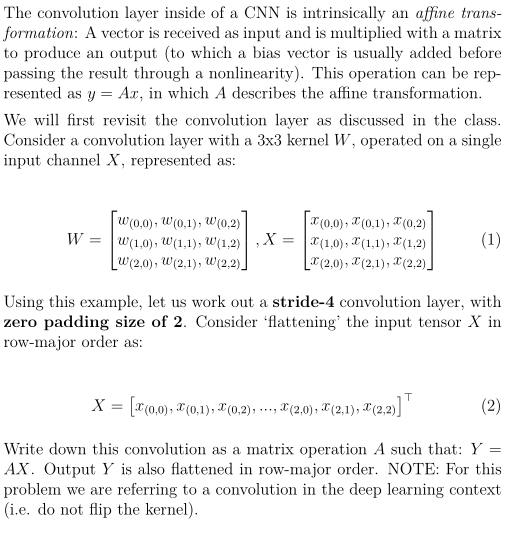Answered step by step
Verified Expert Solution
Question
1 Approved Answer
The convolution layer inside of a CNN is intrinsically an affine trans- formation: A vector is received as input and is multiplied with a

The convolution layer inside of a CNN is intrinsically an affine trans- formation: A vector is received as input and is multiplied with a matrix to produce an output (to which a bias vector is usually added before passing the result through a nonlinearity). This operation can be rep- resented as y= Ax, in which A describes the affine transformation. We will first revisit the convolution layer as discussed in the class. Consider a convolution layer with a 3x3 kernel W, operated on a single input channel X, represented as: W = w(0,0), W (0,1), W (0,2) W(1,0), W(1,1), W(1,2) [W(2.0), W(2,1), W (2,2) , X = x(0,0), (0,1), (0,2) (1,0), (1,1), (1,2) (2,0), (2,1), X(2,2) (1) Using this example, let us work out a stride-4 convolution layer, with zero padding size of 2. Consider 'flattening' the input tensor X in row-major order as: T X = [x(0,0), *(0,1), (0.2) , ---, X (2,0), (2,1), X(2,2)] (2) = Write down this convolution as a matrix operation A such that: Y AX. Output Y is also flattened in row-major order. NOTE: For this problem we are referring to a convolution in the deep learning context (i.e. do not flip the kernel).
Step by Step Solution
★★★★★
3.33 Rating (153 Votes )
There are 3 Steps involved in it
Step: 1
To write down the convolution as a matrix operation A we need to determine the entries of the matrix ...
Get Instant Access to Expert-Tailored Solutions
See step-by-step solutions with expert insights and AI powered tools for academic success
Step: 2

Step: 3

Ace Your Homework with AI
Get the answers you need in no time with our AI-driven, step-by-step assistance
Get Started


